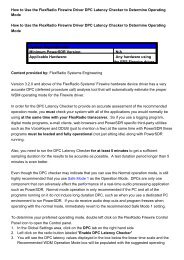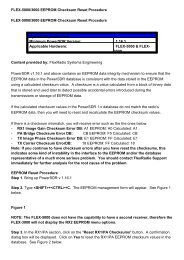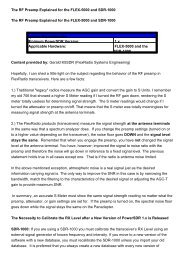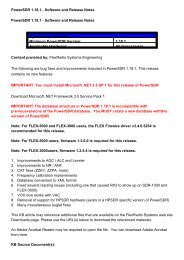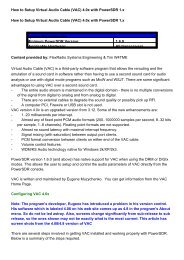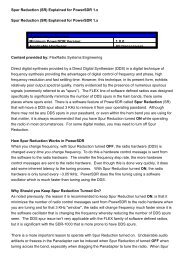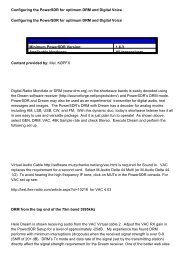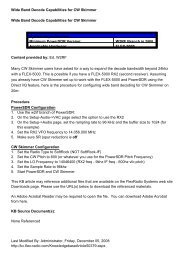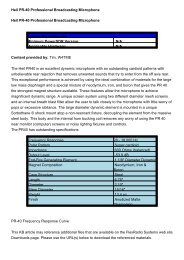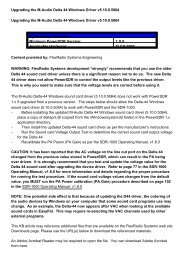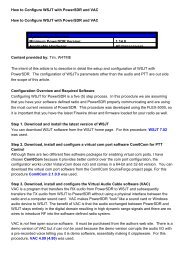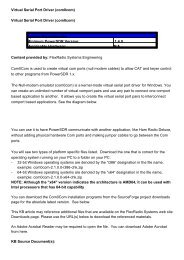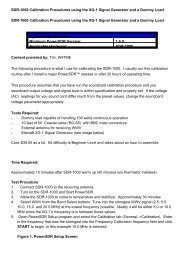Keying an Amp with the SDR-1000 Using the X2 Connector Keying ...
Keying an Amp with the SDR-1000 Using the X2 Connector Keying ...
Keying an Amp with the SDR-1000 Using the X2 Connector Keying ...
Create successful ePaper yourself
Turn your PDF publications into a flip-book with our unique Google optimized e-Paper software.
<strong>Keying</strong> <strong>an</strong> <strong>Amp</strong> <strong>with</strong> <strong>the</strong> <strong>SDR</strong>-<strong>1000</strong> <strong>Using</strong> <strong>the</strong> <strong>X2</strong> <strong>Connector</strong><br />
<strong>Keying</strong> <strong>an</strong> <strong>Amp</strong> <strong>with</strong> <strong>the</strong> <strong>SDR</strong>-<strong>1000</strong> <strong>Using</strong> <strong>the</strong> <strong>X2</strong> <strong>Connector</strong><br />
System Dependencies<br />
Minimum Power<strong>SDR</strong> Version: 1.8.0<br />
Applicable Hardware:<br />
<strong>SDR</strong>-<strong>1000</strong><br />
Content provided by: Larry, K2LT<br />
I am trying to key <strong>an</strong> amplifier <strong>with</strong> my new Flex. Pin 7 on <strong>X2</strong> measures 60 ohms to ground on<br />
st<strong>an</strong>dby <strong>an</strong>d doesn't ch<strong>an</strong>ge much when I key <strong>the</strong> Flex. What am I doing wrong? C<strong>an</strong> someone<br />
furnish a schematic? I have a 5VDC SPST relay that I would like to use to act as a buffer between<br />
<strong>the</strong> Flex <strong>an</strong>d my 4K Ultra.<br />
Answer:<br />
The <strong>X2</strong>-7 pin is driven by a darlington that goes to ground when activated. The easiest test is poke<br />
a 1 K resistor into Vcc pin 14 <strong>an</strong>d pin 7. Measure <strong>the</strong> voltage from pin 7 to ground. St<strong>an</strong>dby is 5 V<br />
<strong>an</strong>d keyed is close to 0 V. A st<strong>an</strong>dard ohmmeter doesn't supply enough voltage to show a<br />
me<strong>an</strong>ingful test.<br />
As long as <strong>the</strong> resist<strong>an</strong>ce of your 5 volt relay coil is 100 ohms or greater <strong>the</strong>n <strong>the</strong> Vcc pin 14 c<strong>an</strong><br />
operate it. Hook pin 8 to <strong>the</strong> Vcc pin 14 to provide a back diode protection across <strong>the</strong> coil. The coil<br />
goes between pin 14 <strong>an</strong>d pin 7.<br />
You will need to spend quality time <strong>with</strong> grounding everything toge<strong>the</strong>r <strong>an</strong>d maybe a few ferrite<br />
beads on <strong>the</strong> control cables too.<br />
Wally M0ZAZ is working on a solid state driver interface called <strong>the</strong> Poor M<strong>an</strong>s Universal Control<br />
Board.that will make it easy to hook amps to <strong>the</strong> <strong>SDR</strong>-<strong>1000</strong>. His email is wawatson@erols.com.<br />
Follow Up Question:<br />
I connected it just <strong>the</strong> way you you indicated above <strong>an</strong>d when I connect it to my amp it<br />
immediately keys it even though I have not keyed <strong>the</strong> <strong>SDR</strong>-<strong>1000</strong>. As indicated before, pin 7 is<br />
only 60 ohms above ground <strong>an</strong>d when I connect it to <strong>the</strong> coil of <strong>the</strong> 5VDC mini relay, <strong>the</strong> relay<br />
keys immediately, which keys my amp. I am connecting pin 14 to <strong>the</strong> top of <strong>the</strong> relay coil, as well<br />
as pin 8. The bottom of <strong>the</strong> relay coil goes to pin 7. Since <strong>the</strong>re is always 5vDC on pin 14 <strong>an</strong>d pin<br />
7 is only 60 ohms from ground, <strong>the</strong> relay energizes. What is going on????<br />
Follow Up Answer:<br />
Content provided by: Jim, W6RMK<br />
You have a "shortput" or shorted output caused by some previous event like trying to key <strong>an</strong> older<br />
amp <strong>with</strong>out a protection diode across <strong>the</strong> relay coil. Or maybe static electricity got <strong>the</strong> pin 7
darlington <strong>with</strong> <strong>the</strong> winter heating season low humidity.<br />
Fortunately <strong>the</strong>re is a way around <strong>the</strong> fault. Pick one of <strong>the</strong> <strong>X2</strong> connector external control lines pins<br />
1-6. These have <strong>the</strong> same output stages as pin 7.<br />
You set up <strong>the</strong>se pins in <strong>the</strong> Ext Ctrl Tab (Setup Program) <strong>an</strong>d once programmed <strong>the</strong>y act just like<br />
pin 7. Even <strong>the</strong> "enable <strong>X2</strong> TR sequencing" <strong>an</strong>d <strong>the</strong> "<strong>X2</strong> delay" settings in General/Options setup<br />
work. So you have six more outputs.<br />
Do <strong>the</strong> resistor test first on <strong>the</strong> pin of your choice to be sure it is working.<br />
I am not a f<strong>an</strong> of hooking relays directly to <strong>the</strong> <strong>X2</strong> connector. Too hard to replace that little surface<br />
mount chip that is 3 boards down in <strong>the</strong> stack. If <strong>the</strong> relay has a GOOD back diode across <strong>the</strong> coil<br />
<strong>the</strong>n that should prevent <strong>the</strong> inductive kick from creating <strong>the</strong> HV spike that blows <strong>the</strong> output<br />
darlington. The naked relay coil acts like a spark coil in <strong>an</strong> ignition system.<br />
There was a great discussion a month ago about back diodes <strong>an</strong>d Jim Lux came up <strong>with</strong> <strong>an</strong><br />
application note from Tyco that provided <strong>an</strong> improvement on <strong>the</strong> back diode by adding a zener to<br />
<strong>the</strong> string. This gave <strong>the</strong> optimal control for <strong>the</strong> relay coil discharge time.<br />
I quote <strong>with</strong>out Jim's permission:<br />
"I would suggest that before embarking on such a design that you read what <strong>the</strong> relay<br />
m<strong>an</strong>ufacturers have to say about tr<strong>an</strong>sient suppression (hint, a diode across <strong>the</strong> coil isn't <strong>the</strong><br />
recommendation)."<br />
http://relays.tycoelectronics.com/appnotes/ has a series of app notes: The first one (application of<br />
coil suppression <strong>with</strong> DC relays) is a good one, as is <strong>the</strong> "Coil suppression c<strong>an</strong> reduce relay life"<br />
They recommend ei<strong>the</strong>r a suitable zener across <strong>the</strong> tr<strong>an</strong>sistor (so that <strong>the</strong> voltage doesn't exceed<br />
<strong>the</strong> Vceo breakdown) or a resistor. Typically a 20-30 V zener is appropriate. Some commercially<br />
available driver devices include <strong>the</strong> zener, or have <strong>the</strong> output tr<strong>an</strong>sistor designed to tolerate <strong>the</strong><br />
breakdown (<strong>the</strong> latter is particularly common in electronic ignitions, where you have a 400 V<br />
tr<strong>an</strong>sient to deal <strong>with</strong>)."<br />
This KB article may reference additional files that are available on <strong>the</strong> FlexRadio Systems web site<br />
Downloads page. Please use <strong>the</strong> URL(s) below to download <strong>the</strong> referenced materials.<br />
An Adobe Acrobat Reader may be required to open <strong>the</strong> file. You c<strong>an</strong> download Adobe Acrobat<br />
from here.<br />
KB Source Document(s):<br />
NoneReferenced
Last Modified By: Administrator, Friday, August 08, 2008<br />
http://kc.flex-radio.com/KnowledgebaseArticle50164.aspx<br />
Thursday, July 23, 2009



